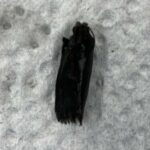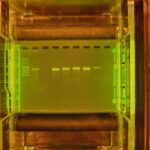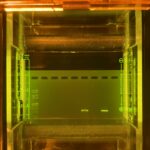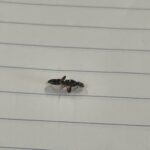Sample information |
|
| Picture |




|
|---|---|
| Location | |
| Collection date | 07/21/2022 |
| Captive / Cultivated? | Wild-caught |
| Group | Edmund Burke School |
| Observations | We weren’t the ones who collected the arthropod, so we aren’t sure the circumstances under which it was caught. |
| Putative identification | Arthropoda Insecta Lepidoptera |
Methods |
|
| Extraction kit | DNeasy (Qiagen) |
| DNA extraction location | Whole arthropod |
| Single or Duplex PCR | Single Reaction |
| Gel electrophoresis system | MiniOne |
| Buffer | TBE |
| DNA stain | GelGreen |
| Gel images |




|
| Protocol notes | DNA extraction: The whole moth was used. Gel electrophoresis lanes: Lane 1: 10kb DNA Ladder Analysis: We know the results for the arthropod and Wolbachia tests for the A-4 sample are reliable because the sample tested positive for arthropod DNA and the results have no contamination because our controls tested correctly. |
Results |
|
| Wolbachia presence | No |
| Confidence level | Medium |
| Explanation of confidence level | The sample tested negative for Wolbachia. Our confidence level is medium. There is a small chance that our results aren’t all completely accurate, because there was an error with our A-2 sample during one of our procedures that resulted in it testing negative for the CO1 gene. Even though the A-2 sample was cut from our results, it still goes to show that human error is always possible. |
| Wolbachia 16S sequence | |
| Arthropod COI sequence | Download FASTA
Download AB1
ATATTAGGAACTTCTTTGAGATTATTAATTCGAGCTGAATTAGGAAACCCAGGATCTTTAATTGGAGATGATCAAATTTA TAATACAATTGTAACTGCTCATGCTTTTATTATAATTTTTTTTATAGTTATACCAATTATAATTGGAGGATTTGGAAATT GATTAGTTCCTTTAATACTAGGAGCCCCAGATATAGCATTCCCACGAATAAATAATATAAGTTTTTGACTATTACCCCCA TCATTAACTTTATTAATTTCAAGAAGAATTGTCGAAAATGGAGCTGGAACAGGATGAACTGTTTACCCTCCCCTATCTTC TAACATTGCTCACGGAGGTGGATCAGTAGATTTAGCAATTTTTTCTTTACATTTAGCTGGAATTTCCTCAATTCTAGGAG CTGTAAATTTTATTACAACAGTAATTAATATACGGACCATTGGAATATCCTTTGATCGTATACCTTTATTTGTTTGATCT GTAGCAATTAC
BLAST at The Wolbachia Project BLAST at NCBI
|
| Summary | The Lepidoptera was found to be negative for Wolbachia. |
 European Paper Wasp
European Paper Wasp Woodworm Ant
Woodworm Ant